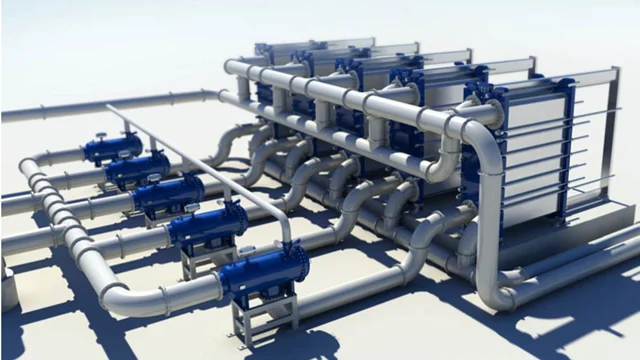Introduction
Closed Cooling Water System is a highly efficient and sustainable solution used across various industrial sectors to regulate temperatures and prevent overheating of critical machinery, equipment, and processes. Unlike open-loop cooling systems that continuously draw water from external sources, closed systems recirculate water in a closed loop, ensuring minimal water loss and reduced environmental impact. These systems are designed to remove excess heat from equipment, such as engines, turbines, reactors, and manufacturing processes, by circulating coolant water through heat exchangers or cooling towers. As the water circulates, it absorbs the heat from the equipment and either dissipates it through evaporation or transfers it to another cooling medium, ensuring the equipment operates within safe temperature limits.
Key Components of a Closed Cooling Water System:
- Chiller or Heat Exchanger: The primary component responsible for removing heat from the water and transferring it to a secondary medium, such as air or a refrigerant.
- Cooling Tower (if applicable): In some cases, a cooling tower may be used to release heat absorbed by the water into the atmosphere through evaporation.
- Pumps: These are used to circulate the water through the entire system, ensuring a continuous flow to the cooling equipment.
- Piping Network: The system of pipes that carries water to and from the equipment being cooled.
- Expansion Tank: This helps manage the pressure changes within the closed loop as the water expands and contracts due to temperature changes.
- Filtration and Chemical Treatment: Filters remove contaminants, and chemical treatments prevent scaling, corrosion, and biological growth inside the system.
How Closed Cooling Water Systems Work:
- Water is circulated through the system to absorb heat from the machinery or process being cooled. This heated water is then transported to the heat exchanger or cooling tower.
- In the case of a heat exchanger, the heat is transferred to another medium (like refrigerant or air), which helps cool the water.
- The cooled water is then returned to the system to continue the cycle.
- In some systems, a cooling tower may be involved, where water is exposed to air to release heat through evaporation, effectively lowering the water temperature.
Advantages of a Closed Cooling Water System:
- Water Conservation: Since the system is a closed loop, it requires less water than open-loop systems, as there is minimal evaporation or loss of water.
- Reduced Contamination: The closed-loop prevents contamination of the cooling water with dirt, debris, or algae growth, which is common in open-loop systems.
- Lower Environmental Impact: Since water is reused, there is less impact on local water sources. Additionally, water discharge into the environment is minimized.
- Better Control: Closed systems offer better control over water quality and temperature, as the water doesn’t interact with the external environment.
- Reduced Maintenance: Because the water doesn’t come into contact with external contaminants, there is less buildup of minerals, scale, and corrosion, reducing maintenance needs.
Applications of Closed Cooling Water Systems:
- Power Plants: Used for cooling steam turbines and other equipment.
- Chemical and Petrochemical Plants: Cooling reactors, heat exchangers, and condensers.
- HVAC Systems: Large commercial buildings, data centers, and industrial facilities use closed-loop systems for air conditioning.
- Manufacturing and Metal Processing: Cooling machinery, molds, and high-temperature equipment.
- Food and Beverage: Cooling processes in manufacturing plants that involve heat-sensitive products.
- Pharmaceuticals: Maintaining controlled temperatures in manufacturing equipment and processes.
Key Considerations for Closed Cooling Water Systems:
- Maintenance: While closed systems require less maintenance than open systems, they still need regular checks for leaks, pressure, and water quality. Filtration and chemical treatment are critical for preventing corrosion, scaling, and microbial growth.
- System Design: Proper system design is crucial for ensuring that the cooling loop is sized correctly and functions efficiently. This includes selecting the right pumps, heat exchangers, and cooling towers (if used).
- Energy Efficiency: The efficiency of the closed-loop system depends on factors such as the heat exchanger’s effectiveness, pump size, and the ability of the system to maintain consistent temperature control.
Conclusion
Closed Cooling Water System is a highly efficient solution for industries that require continuous and controlled cooling. By recycling water within the system and using heat exchangers or cooling towers, these systems help conserve water, reduce contamination, and maintain a stable operating environment for equipment. They are widely used in power generation, manufacturing, HVAC systems, and other industries that rely on cooling for optimal performance.

